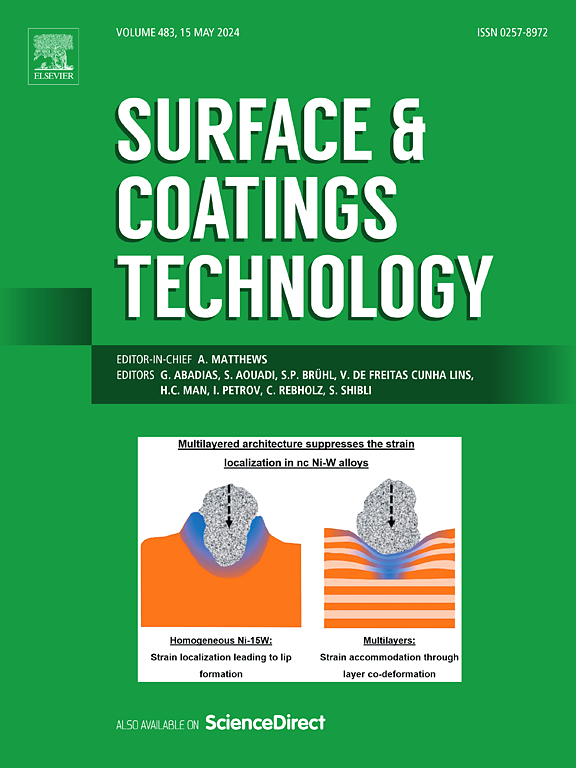激光熔覆CoCrFeNiSnx复合涂层的强化机理:显微组织和摩擦学性能
IF 5.3
2区 材料科学
Q1 MATERIALS SCIENCE, COATINGS & FILMS
引用次数: 0
摘要
为了证明Sn改善摩擦性能的可行性,采用激光熔覆技术分别制备了CoCrFeNiSnx (x = 0,0.5, 0.75, 1, x值为摩尔比)高熵合金复合涂层,并在室温(25°C)和600°C下对其组织和磨损行为进行了研究。结果表明,所有涂层均由面心立方(FCC)固溶体和Ni3Sn2相组成。随着Sn含量的增加,镀层显微硬度逐渐升高,达到787.69 HV0.5。高硬度、高加工硬化能力、作为非均相形核点的Ni3Sn2的细晶强化和Sn对位错运动的阻滞作用。这些增强行为协同作用使CoCrFeNiSn1涂层具有最佳的摩擦学性能,在室温下具有良好的耐磨性(2.5 × 10−6 mm3 / N·m),与无sn涂层相比降低了89.49%。在600℃时,由SnO2、CoO和NiO氧化物组成的高密度氧化膜和由Cr2O3重构的摩擦膜协同作用于涂层表面,与基体相比,氧化磨损率降低了63.52%。本研究有望为Q235钢在关键磨损领域的应用提供一定的数据支持。本文章由计算机程序翻译,如有差异,请以英文原文为准。
Strengthening mechanisms of laser cladded CoCrFeNiSnx composite coatings: Microstructure and tribological properties
In order to demonstrate the feasibility of Sn to improve tribological properties, CoCrFeNiSnx (x = 0, 0.5, 0.75, 1, x values are molar ratios) high-entropy alloy composite coatings were prepared separately by laser cladding technique and their microstructures and wear behavior were investigated at room temperature (25 °C) and 600 °C. The relevant results showed that all the coatings consist of face-centered cubic (FCC) solid solution and Ni3Sn2 phase. The microhardness of the coatings gradually increased with increasing Sn content to 787.69 HV0.5. High hardness, high work-hardening capacity, fine-grain strengthening of Ni3Sn2 as a heterogeneous nucleation point and blocking effect of Sn on dislocation movements. These enhancement behaviors acted synergistically to give the CoCrFeNiSn1 coating the best tribological properties, with good wear resistance (2.5 × 10−6 mm3 / N·m) at room temperature, which was reduced by 89.49 % comparison with Sn-free coating. At 600 °C, a highly dense oxide film consisting of SnO2, CoO and NiO oxides and a friction film reconstructed from Cr2O3 acted synergistically on surface of the coating, reducing the wear rate due to oxidative wear by 63.52 % compared to the substrate. This study was expected to offer some data support for the application of Q235 steel in wear-critical areas.
求助全文
通过发布文献求助,成功后即可免费获取论文全文。
去求助
来源期刊

Surface & Coatings Technology
工程技术-材料科学:膜
CiteScore
10.00
自引率
11.10%
发文量
921
审稿时长
19 days
期刊介绍:
Surface and Coatings Technology is an international archival journal publishing scientific papers on significant developments in surface and interface engineering to modify and improve the surface properties of materials for protection in demanding contact conditions or aggressive environments, or for enhanced functional performance. Contributions range from original scientific articles concerned with fundamental and applied aspects of research or direct applications of metallic, inorganic, organic and composite coatings, to invited reviews of current technology in specific areas. Papers submitted to this journal are expected to be in line with the following aspects in processes, and properties/performance:
A. Processes: Physical and chemical vapour deposition techniques, thermal and plasma spraying, surface modification by directed energy techniques such as ion, electron and laser beams, thermo-chemical treatment, wet chemical and electrochemical processes such as plating, sol-gel coating, anodization, plasma electrolytic oxidation, etc., but excluding painting.
B. Properties/performance: friction performance, wear resistance (e.g., abrasion, erosion, fretting, etc), corrosion and oxidation resistance, thermal protection, diffusion resistance, hydrophilicity/hydrophobicity, and properties relevant to smart materials behaviour and enhanced multifunctional performance for environmental, energy and medical applications, but excluding device aspects.
 求助内容:
求助内容: 应助结果提醒方式:
应助结果提醒方式:


